55TH ANNUAL CONFERENCE, Las Vegas, USA, 14-18 March 2016WP No. 303Cognitive Processes in Air Traffic ControlPresented by PLC |
Summary
The air traffic controller profession has great demands on the cognitive functioning of the brain. What makes it challenging is not only the combined activities of ‘information processing’ and ‘planning / decision-making’, but also the fact that ATCO’s need to do this in a constantly changing environment.
In this paper, it is shown how air traffic controllers reduce cognitive complexity by filtering the available information and adding structure with rules and routines. However, there is a limit to what the mind can handle. Our cognitive capacity can be even further reduced by increasingly complex systems, interference, distractions, ageing and switching between multiple modes of operation.
The human is the highly skilled centre of the ATM system. When implementing new technology and working methods, it must not be overlooked that the proposed changes should be a help, not a burden. Therefore the limitations to cognitive functioning should be examined when Human Factors and Human Performance are addressed.
Introduction
1.1 Several recent developments have led to the need for IFATCA to further explore the mind of an air traffic controller. In regard to Human Factors in technological trends, the capacities and limitations of cognitive processes in the brain are in need of investigation.
1.2 The limits to our cognitive functioning are a fundamental basis for several current topics IFATCA addresses. One of them is automation in air traffic control. New ATM systems, such as multiple remotely operated tower services, can considerably challenge the mind of an air traffic controller. A review of IFATCA’s automation policy is presented at this conference (Las Vegas 2016 WP C.6.9).
1.3 Other relevant subjects are Ageing ATCO’s (Las Vegas 2016 WP C.6.1), Educational Issues on Distraction (Las Vegas 2016 WP C.6.3) and sector manning.
1.4 This paper serves as a theoretical foundation for the topics mentioned above. It aims to clarify the cognitive processes of an ATCO, explain cognitive complexity and its limitations and relate this to current ATM challenges. It also emphasises Human Factors in the process of developing air traffic management systems.
Discussion
2.1 The Executive Function of the brain
2.1.1 The Executive Function (also known as cognitive control) is one of the most important activities in the brain. It underlies a broad range of life skills, competencies and behavioural factors. It refers to the ability to coordinate thought and action and to direct it to achieve goals.
2.1.2 The Executive Function consists of several mental skills that help the brain organise and act on information. It takes over when we switch from ‘automatic mode’ to ‘controlled/conscious mode’: from a situation with ‘bottom-up’ control of behaviour (e.g. driving the daily route to work, familiar and little awareness needed) to where we ‘take charge’ of our actions when straightforward stimulus-response associations are not sufficient (e.g. getting stuck in a traffic jam, goal is to arrive at work in time).
2.1.3 A large portion of the brain facilitates the ability for cognitive control, but it is commonly held that the prefrontal cortex is particularly important. The prefrontal cortex is not critical when performing simple, automatic behaviours, but comes into play when behaviour must be guided by internal states or intentions. Miller and Cohen (2001) argue that cognitive control is the primary function of the prefrontal cortex and that by sending bias signals throughout the rest of the brain, task- appropriate responding is triggered.
2.1.4 More specifically for air traffic control tasks, the Executive Function includes:
– working memory (being able to remember information for a short time);
– inhibitory control (master thoughts and impulses, thus being able to determine what is relevant to the working memory and the ability to shut out irrelevant things); and
– cognitive flexibility (adjust to changing perspectives and priorities, thus applying different rules in different settings).
2.1.5 The Executive Function is critical throughout an ATCO’s work whenever planning or decision- making is needed, in complex situations where regular knowledge-based behaviour is not sufficient and when coping with changing mental representations.
2.2 Situation Awareness
2.2.1 Air traffic controllers have a global mental representation of the current and future traffic situations. Often referred to as ‘the picture’ (Whitfield and Jackson, 1982), this can also be described as situation awareness (SA) (Endsley, 1995). For an ATCO, to have situation awareness requires a high level of focus that involves far more than being aware of numerous pieces of data. In his Model of SA in Dynamic Decision Making (below), Endsley argues that there are three different levels of situation awareness: perception, comprehension and projection. Higher levels depend on the success of lower levels:
-
- The most basic level of SA involves the processes of monitoring, cue detection and simple recognition.
- In the next step, the level 1 elements are integrated into understanding how it will impact on the ATCO’s goals and objectives, through the processes of pattern recognition, interpretation and evaluation.
- The highest level of SA involves the ability to project the future actions of the elements in the environment, achieved through knowledge of status and dynamics of the elements and comprehension of the situation (Levels 1 and 2).
2.2.2 Endsley’s theory is widespread and has been cited extensively in other research for years. However, is has also been criticised. For instance, Dekker and Hollnagel (2004) argue that the term situation awareness is an unnecessary ‘top layer’ above more specific terms as ‘attention’ and ‘perception’ and the term SA cannot be falsified. With this, Dekker and Hollnagel mean that in many incident reports ‘a loss of situation awareness’ is used as one of the causes that led to the incident. It is hard not to disagree with that, because ‘the assertion is underspecified and therefore immune against falsification’ (Dekker, S and Hollnagel, E: Human Factors and Folk Models, In: Cognition, Technology and Work, 2004). By this, Dekker and Hollnagel mean that the term ‘situation awareness’ is too general and almost impossible not to link to an incident where human performance plays a part. However, in this paper the term is used because of its broad acceptance.
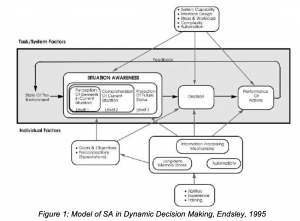
2.3 Cognitive Modelling
2.3.1 There are several models for the cognitive processes of air traffic. In contradiction with (at that time) the most widely used concepts for adaptive control of complex task environments (Anderson, 1993; Rasmussen, 1986; Hacker, 1978), both Eurocontrol (1997) and Niessen et al. (1998) developed models that take into account that in dynamic situations, an ATCO has to continuously update the mental representation and does not follow a pre-defined goal hierarchy. 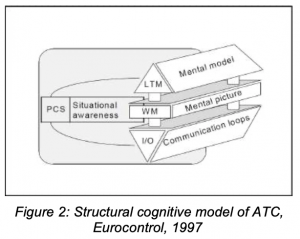
2.3.2 In the ‘Model of the Cognitive Aspects of Air Traffic Control’ (Eurocontrol, 1997), cognition in ATC is described as a primarily top- down process where controllers do not continuously react to changing events, but act proactively to pre-formatted plans, rules and the mental picture of the situation.
To do this, anticipation of future system states is of crucial importance.
2.3.4 Niessen et al. (1998) have a more dynamic approach to modelling the cognitive abilities of air traffic controllers. They acknowledge three stages in the diagnosis of potential conflicts: observing, analysing and anticipating. These stages could be linked to Endsley’s stages of situation awareness.
2.3.5 On the basis of a broad research among En-route air traffic controllers, a model (MoFi, Modell der Fluglotsenleistungen) of their cognitive activities was made. MoFi consists of three main cycles of information processing, operating on different parts of the mental representation (or picture):
- Monitoring cycle (includes data selection procedures and regular update of aircraft features).
- Anticipation cycle (for each attention demanding aircraft/relationships, a future state is anticipated separately).
These two cycles result in what Niessen et al. call picture; an active knowledge-based construction of meaningful relations between elements, not stored in the long-term memory. - The problem resolution cycle then initiates the steps to prevent an impending conflict. This is done by first generating or recalling solutions, anticipating what will happen after the solution is chosen, and ultimately taking action.
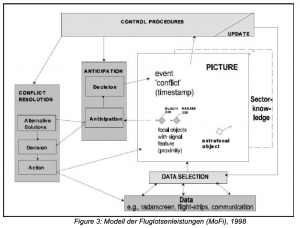
2.4 Cognitive complexity
2.4.1 Cognitive complexity cannot be directly observed; therefore it must be investigated indirectly, by observing the controller in the ATM system.
2.4.2 After conducting experimental research on air traffic controllers, Niessen et al. (1999) found that the controller’s representation of the traffic situation is built by reducing all the available information very quickly to the essential information that is important for identifying aircraft, integrating them into the situation and anticipating future states. Bearing in mind a constantly changing representation and prioritisation, the only way to be able to perform such a complex task is to be able to reduce all data available to the absolute minimum.
2.4.3 In a 2002 paper on cognitive complexity in air traffic control (Histon et al.), researchers presented a simple model that shows the relationship between basic tasks of air traffic control and cognitive complexity, using Endsley’s three levels of situation awareness.
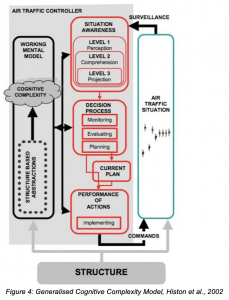
2.4.4 In this model, the controller receives surveillance information and processes it to produce a set of output commands. Cognitive complexity is associated with the working mental model of the controller and structure is presumed to be a basis for complexity reducing abstractions and allowing the capacity of the ATC system to be higher. According to the researchers, this structure ‘may sufficiently reduce controller’s cognitive load, to allow more flexibility for the aircraft in the system’ (Histon, J., Hansman, J., Gottlieb. et al., 2002: Structural considerations and cognitive complexity in air traffic control. DASC 2002, 21st Digital Avionics Systems Conference, USA). There are more recent studies (e.g. Inuoe et al. 2012), that also introduce a basis or structure that can reduce cognitive complexity for the controller. This can be referred to as ‘strategic routines’ that are executed within a very short time, leading to a rule-based cognitive process.
2.5 Capacity limits of cognitive control
2.5.1 In the preceding paragraphs, cognitive processes and complexity have been introduced. It is argued that ATCOs manage their cognitive load by extracting essential information and using a structure as basis for their decision-making. Despite all this, there are limits to what our mind can bear: controllers can become overloaded when the cognitive complexity of a situation exceeds their capabilities.
2.5.2 The human brain with its elaborate sensory and motor systems gives us many opportunities, but at the same time makes us sensitive to interference and confusion. The cognitive function has a severely limited capacity, which is evident to anyone who has tried to do two mind-challenging tasks at the same time. It is impossible to properly sequence a line of aircraft while at the same trying to solve a difficult math problem.
2.5.3 This complexity can be further explained using two practical examples, in which present-day and future problems are addressed:
Example 1
Alex is an experienced area controller. In his airspace, he works both En-route traffic and inbound/outbound flights to a major airport. To distinguish between different types of aircraft, his radar labels are presented in four different colours: green, blue, purple and yellow, with different shaped plots to indicate which sector is working which aircraft. Since last year, STCA (flashing orange) and TCAS TA/RA downlink (steady/flashing red) are shown on the screen as well. Labels are quite large, as they now also include PSL (flashes when it deviates) and IAS.
When there are delays and holding is necessary, the radar screen is automatically divided in normal and vertical view. This way, Alex can work two visual modes simultaneously and is able to differentiate between the aircraft in the hold. It took him a long time to get used to this way of working. In the simulator environment where Alex has his recurrent training, the vertical view will be introduced in two years from now. Until that time, controllers will continue to use paper strips to practice holding procedures.
Beside the radar screen, Alex has two extra monitors, one is presenting information on military activities and the other one provides weather information. They are both controlled using a mouse; Alex works with a total of three mice. Last week, a tablet was built in to every console. With this, controllers can look up procedures without having to browse through a book. The tablet is touchscreen.
The supervisor desk is situated close to the sector Alex is working on. All personnel starting their shift or returning from break gather here to look at the schedule and hear the latest news. Their loud chatting can distract Alex: sometimes he can’t even hear a pilot’s call, or remember the information that was given to him. Luckily, his voice communication system can play back the last calls. When the button is pressed, he hears the last two calls in his other ear. Some colleagues complain that this can be confusing while hearing live calls at the same time.
Example 2
Rose is one of the first to work in a remotely operated tower environment. In her 10 years as a tower controller at Northern Airport, she noticed the decline in air traffic. She is very happy with her new working environment: a central control centre close to her home, from where she remotely works two airports. Northern Airport -which is presented beautifully lifelike on a large screen on one side- and Western Airport, shown on the other side of the control room. Rose has never worked at Western Airport, but simulator training was provided. Rose notices that it takes some time to adjust when switching between the two airports; they have different layouts and thus have other reference points. Luckily, both airports are quite low on traffic.
Last week however, Rose was working VFR crossing traffic and IFR inbounds for runway 01 at Northern Airport. At that moment, Area control coordinated a medical emergency diverting to Western Airport for runway 27. When issuing the landing clearance, Rose accidentally called out Northern airport’s runway 01 with the corresponding wind. She was able to correct this quickly.
Tim, one of Rose’s colleagues, is still in training to work at the remote centre. He has been a tower controller at Northern for almost 20 years. Before that, he worked 10 years at Western Airport. Rose thought Tim would be the first one working solo, having so much experience. But Tim says that switching between the two airports is difficult for him, even when traffic is low.
The management is very enthusiastic about the remotely operated tower concept and has plans to control five airports from the same remotely operated tower facility within the next five years. The technique is already being implemented, but it is not yet clear how many airports Rose will control simultaneously.
2.5.4 From these examples, various factors can be derived, which can affect the cognitive capacity of an ATCO:
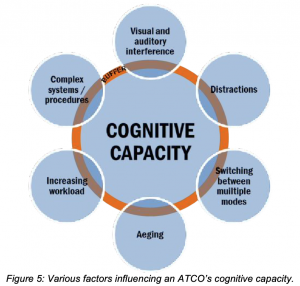
2.5.5 Visual and auditory interference
As shown in the first example, a controller receives information by many visual and auditory means. Both are very sensitive to interference and confusion.
It is known that when an information-processing task is performed in the brain, two or more active processes may use the same source. There will be no interference with each other, until the moment that they are forced to operate in the resource-limited region of their function, or when there are limits in the quality of data being available to the processes (Norman and Bobrow, 1975). With the tasks of the ATCO lying in the same cognitive regions, the chance of them interfering is high. Usher and Cohen (1999) suggested that there are a limited number of representations that can be held actively and independently in the working memory, depending on the buffer or on how much activation can be shared.
2.5.6 The ATCO’s cognitive ‘buffer’
Looking broader, every professional that combines thinking with practical output needs an extra mental buffer to be able to cope with unforeseen increasing workload. Besides obvious stressful situations such as emergencies, this buffer is also needed during normal operations, e.g. for extra traffic or complexity. This buffer is automatically maintained by an ATCO, preventing overload in almost any situation.
2.5.7 Mode confusion and mode switching
Confusion in information receiving depends heavily on the system presenting this information to the controller. The increase amount of automated systems in air traffic control has brought new demands: behaviour of new systems must be understood, including the different ‘modes’ that the system can operate in. Sarter, Woods and Billings (1997) identified the existence of ‘automation surprises’: practitioners are confronted with unpredictable and difficult to understand system behaviour in the context of ongoing operations (Sarter, Woods, Wiley – Automation Surprises, Handbook of Human Factors & Ergonomics, second edition, G. Salvendy (Ed.), Wiley, 1997).
Mode confusion arises when there is a difference between the mode that the system is in, and the mode that the human operator has built a mental model for.
It is essential for the human to have an appropriate mental model of the mode that they are operating in, and to be able to anticipate on a different mode, including the transition in between. This can be called ‘mode switching’: the transition between two mental models that the human operator requires to operate in are two different modes of operation of a technical or automated system.
Mode switching can be very difficult for the brain. For instance when working both normal and vertical radar view, or when controlling two different airports simultaneously. A single controller keeping two mental models ‘live’ and switching between them can lead to reduced situation awareness, longer response times and an increased risk of errors. Also when looking at the longer-term, switching between modes can be an issue: for instance when the simulator training environment is different from the live situation, or when a controller does not work a ‘mode’ for a long time and loses abilities.
2.5.8 Workload management in multiple modes
While information is received and filtered, feeding the controller’s situational awareness, the process of planning and decision-making is started. In this process, the capacity of our brain is tested once more. Actions need to be prioritised, decisions have to be made quickly. A large to-do list and limited time leads to a high workload. When switching between modes, this could be even higher.
In 2011, German researchers investigated the workload in a remotely operated tower environment (Moehlenbrink, Papenfuss, Jakobi, 2011: The Role of Workload for Work Organisation in a Remote Tower Control Centre, Institute of Flight Guidance German Aerospace Centre (DLR)). They recreated a remotely operated tower working environment in a simulator centre, in which they tested several remotely operated tower operations: a single controller operating two airports, a single controller operating one airport and a team of two controllers (executive + coordinator) working one airport or two airports simultaneously. The most interesting findings were:
– for working positions in which controllers were responsible for two airports, a significant increase of workload was measured. But with one controller operating a single airport, there was no higher value on the workload scale. The researchers explained this by assuming that the task to have a mental picture for two airports and task prioritisation of requests for two airports is significantly more demanding. Teaming up with another controller did not resolve this, as both were still responsible for the safe operation of both airports.
– controllers were asked to judge the traffic situations on efficiency and safety impact. Data shows that almost all situations were judged to impact efficiency, safety or both; and one third even as ‘impossible to handle by one controller’. On the other hand, during smooth operations, parallel starts or even landings on both airports were rated as uncritical events.
2.5.9 The effect of ageing
It is well known that ageing has negative effects on cognitive flexibility. Generally, research has shown that experience largely makes up for this. But when new systems are introduced, an older ATCO needs more time to adjust than his younger colleague. It is arguable that when a controller has to switch between multiple modes, it will be harder to cope with the effects of cognitive complexity, especially when getting older. Experience builds up quickly when an environment is stable, but is hard to gain when this is changing.
This conference, PLC presents a detailed paper on ageing ATCO’s, including a review of the current policy (Ageing air traffic controllers: consequences on job performance, Las Vegas 2016 WP C.6.1).
2.5.10 Distractions
The primary effect of distractions is the breakdown of the normal flow of on-going activities, both mentally and physically. Distraction primarily affects the memory and activates stress: it is easy to forget what we were doing or planning and it often causes the ATCO to feel rushed (Distractions at workplace – presented by PLC. Agenda item C.6.10. IFATCA Annual Conference 2015, Sofia, Bulgaria). As shown in the first practical example in 2.5.3, distractions can lead to missing or forgetting information, leading to a reduced situational awareness and an increased risk of errors.
At the IFATCA conference in Sofia 2015, PLC presented a paper on distractions. This year, guidance material is developed to get hands-on suggestions to support MA’s (Educational Issues on Distraction (Guidance Material), Las Vegas 2016 WP C.6.3).
Conclusions
3.1 The Executive Function of the brain is critical throughout an ATCO’s work, whenever planning or decision-making is needed, in complex situations where regular knowledge-based behaviour is not sufficient and when coping with changing mental representations.
3.2 To have true situation awareness requires a high level of focus, which implies the ability to project the future actions of the elements in the environment, achieved through knowledge of status and dynamics of the elements and comprehension of the situation.
3.3 Several models for cognitive processes of ATCO’s have been presented. Niessen et al. (1998) have a dynamic approach in which they acknowledge three stages in the diagnosis of potential conflicts: observing, analysing and anticipating. Air traffic controllers’ cognitive cycle consists of a monitoring cycle, anticipation cycle and problem solving cycle.
3.4 ATCO’s reduce cognitive complexity by filtering all available information and impulses to the absolute necessary, and by using a structure (e.g. rules, strategic routines) as basis for their cognitive processes.
3.5 Despite this, controllers can become overloaded when the cognitive complexity of a situation exceeds their capabilities. The cognitive function has a limited capacity and is vulnerable to interference and confusion. Comprehensive ATC systems can challenge an ATCO, for instance by contributing to visual and auditory interference in the brain. It can also be demanding to operate in two different modes of operation of a technical or automated system, e.g. when working regular and vertical view, or when switching between two or more environments in multiple remotely operated tower systems. Keeping two or more mental pictures ‘alive’ can lead to a reduced situation awareness, longer response times and an increased risk of errors. It is likely to increase the workload of a controller.
3.6 It is well known that ageing imposes restrictions to cognitive functioning. Experience may diminish the effect, but this is harder when one is confronted with changing environments. The topic of distractions at the working position is another example of cognitive challenges.
3.7 For more than 35 years, IFATCA has been drawing attention to the human in the ATM system. With the ATCO not being a line worker, but the highly skilled centre of the system, this apprehension is fully justified. It is still common that the human factor is overlooked and specialists are called in too late when implementing new systems and when introducing challenging working methods. With the ATC world being on the eve of new technological breakthroughs, it is more important than ever to realise that controllers have to be able to mentally keep up with this, and deliver at least the same quality in safety and efficiency.
Recommendations
4.1 It is recommended that:
Capabilities and limitations of cognitive processes shall be considered when addressing Human Performance and Human Factors.
and is included in the IFATCA Technical and Professional Manual.
References
Billings, C.E., 1997: Aviation automation: the search for a human-centred approach. Lawrence Erlbaum Associates, New Jersey.
Davidson and Reynolds, H.J., 2006: Modelling the Air Traffic Controller’s Cognitive Projection Process, MIT International Centre for Air Transportation, MIT Cambridge USA
Dekker, S and Hollnagel, E, 2004: Human Factors and Folk Models, In: Cognition, Technology and Work
Endsley, M.R., 1995: Toward a theory of situation awareness in dynamic systems, Texas Tech University, Texas in: Human Factors, 1995, 37, 32-64, Human Factors and Ergonomics Society.
Histon, J., Hansman, J., Gottlieb. et al., 2002: Structural considerations and cognitive complexity in air traffic control. DASC 2002, 21st Digital Avionics Systems Conference, USA.
Inuoe, S., Furuta, K. et al., 2012: Cognitive Processes modelling of controllers in en route air traffic control, Ergonomics, 55:4, 450-464.
Kirwan, B., date unknown: Safety Assurance for Future Mixed Mode Air Traffic Management Environments, Eurocontrol EEC.
Miller, E.K. and Cohen, J.D., 2001: An Integrative Theory of Prefrontal Cortex Function, in: Annu. Rev. Neuroscience, 2001.24-167.202.
Miller, E.K. and Wallis, J.D., 2009: Executive Function and Higher-Order Cognition: Definition and Neural Substrates in: Encyclopaedia of Neuroscience (2009), vol 4. Pp 99-104
Moehlenbrink, Papenfuss, Jakobi, 2011: The Role of Workload for Work Organisation in a Remote Tower Control Centre, Institute of Flight Guidance German Aerospace Centre (DLR).
National Scientific Council on the Developing Child, 2011: Building the Brain’s “Air Traffic Control” System: How Early Experiences Shape the Development of Executive Function, Centre on the Developing Child – Harvard University.
Niessen C., Leuchter S. and Eyferth, K., 1998: A psychological model of air traffic control and its implementation, in: Proceedings of the Second European Conference on Cognitive Modelling, Nottingham University Press
Niessen, C., Eyferth, K. and Bierwagen, T, 1999: Modelling cognitive processes of experienced air traffic controllers, Ergonomics, 42:11 1507-1520.
Sarter, Woods, Wiley, 1997: Automation Surprises, Handbook of Human Factors & Ergonomics, second edition, G. Salvendy (Ed.), Wiley.
Sherry, Polson, Feary, 2001: DESIGNING USER-INTERFACES FOR THE COCKPIT, Society of Automotive Engineers, Inc.
Shorrock, S.T., 2006: Errors of perception in air traffic control, University of New South Wales.
Vortac, Edwards, Fuller , 1994: Automation and Cognition in Air Traffic Control: An Empirical Investigation, Federal Aviation Administration
Carter Lab: Cognitive Control, website of the University of California, Davis (https://carterlab.ucdavis.edu)
Saab & Frequentis – Remote Tower: a business perspective (SESAR presentations, 2014, https://www.sesarju.eu/sites/default/files/documents/events/remote-day2-business-persp1.pdf)
With Special thanks to:
Dave Bricker, Rob Burgers, Paul Neering, Jez Pigden, Anthony Smoker.


